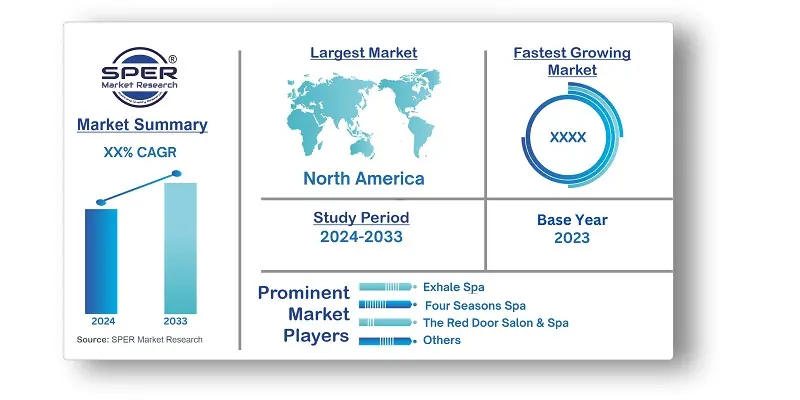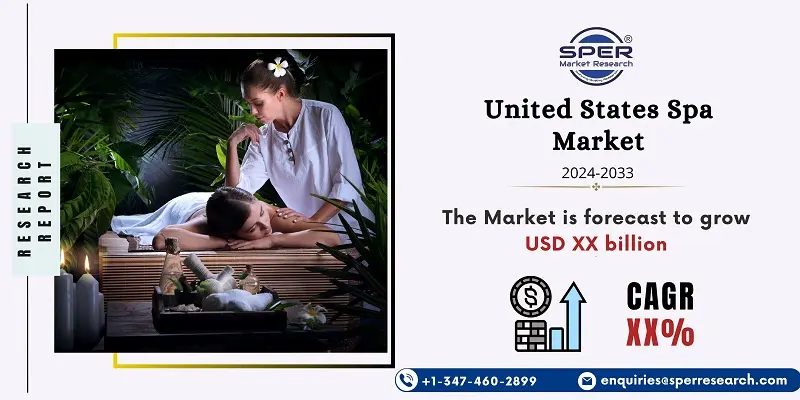
United States Spa Market Trends, Share, Size, Revenue, Demand, Competition and Future Outlook
United States Spa Market Growth, Size, Trends Analysis- By Service Type, By Facility Type, By End User- Regional Outlook, Competitive Strategies and Segment Forecast to 2033
| Published: Nov-2024 | Report ID: FMCG24195 | Pages: 1 - 107 | Formats*: |
| Category : Consumer & Retail | |||
- September 2023; Reports indicated a significant increase in spa bookings, with many facilities experiencing higher-than-expected demand as consumers returned to wellness services.
- August 2023; Several spas announced new eco-friendly initiatives, launching sustainable product lines and implementing green practices.


| Report Metric | Details |
| Market size available for years | 2020-2033 |
| Base year considered | 2023 |
| Forecast period | 2024-2033 |
| Segments covered | By Service Type, By Facility Type, By End User |
| Regions covered | Midwest Region, Northeast Region, Southwest Region, and West Region. |
| Companies Covered | Aveda, Banya 5, Exhale Spa, Four Seasons Spa, Hand & Stone, Massage Envy, The Red Door Salon & Spa, The Ritz-Carlton Spa, The Woodhouse Day Spa. |
- Health and Wellness Enthusiasts
- Affluent Consumers
- Busy Professionals
- Tourists
- Moms and Caregivers
- Fitness Seekers
- Older Adults
- Brides and Event Participants
- Corporate Clients
| By Service Type: | |
| By Facility Type: | |
| By End User: |
- United States Spa Market Size (FY’2024-FY’2033)
- Overview of United States Spa Market
- Segmentation of United States Spa Market By Service Type (By Massage, By Beauty/Grooming, Physical Fitness, Others)
- Segmentation of United States Spa Market By Facility Type (By Resort Spa, By Salon Spa, By Medical Spa, By Destination Spa, Others)
- Segmentation of United States Spa Market by End User (Men, Women)
- Statistical Snap of United States Spa Market
- Expansion Analysis of United States Spa Market
- Problems and Obstacles in United States Spa Market
- Competitive Landscape in the United States Spa Market
- Impact of COVID-19 and Demonetization on United States Spa Market
- Details on Current Investment in United States Spa Market
- Competitive Analysis of United States Spa Market
- Prominent Players in the United States Spa Market
- SWOT Analysis of United States Spa Market
- United States Spa Market Future Outlook and Projections (FY’2024-FY’2033)
- Recommendations from Analyst
1.1. Scope of the report1.2. Market segment analysis
2.1. Research data source2.1.1. Secondary Data2.1.2. Primary Data2.1.3. SPER’s internal database2.1.4. Premium insight from KOL’s2.2. Market size estimation2.2.1. Top-down and Bottom-up approach2.3. Data triangulation
4.1. Driver, Restraint, Opportunity and Challenges analysis4.1.1. Drivers4.1.2. Restraints4.1.3. Opportunities4.1.4. Challenges4.2. COVID-19 Impacts of the United States Spa Market
5.1. SWOT Analysis5.1.1. Strengths5.1.2. Weaknesses5.1.3. Opportunities5.1.4. Threats5.2. PESTEL Analysis5.2.1. Political Landscape5.2.2. Economic Landscape5.2.3. Social Landscape5.2.4. Technological Landscape5.2.5. Environmental Landscape5.2.6. Legal Landscape5.3. PORTER’s Five Forces5.3.1. Bargaining power of suppliers5.3.2. Bargaining power of buyers5.3.3. Threat of Substitute5.3.4. Threat of new entrant5.3.5. Competitive rivalry5.4. Heat Map Analysis
6.1. United States Spa Market Manufacturing Base Distribution, Sales Area, Product Type6.2. Mergers & Acquisitions, Partnerships, Product Launch, and Collaboration in United States Spa Market
7.1. United States Spa Market Size, Share and Forecast, By Service Type, 2020-20267.2. United States Spa Market Size, Share and Forecast, By Service Type, 2027-20337.3. By Massage7.4. By Beauty/Grooming7.5. By Physical Fitness7.6. Others
8.1. United States Spa Market Size, Share and Forecast, By Facility Type, 2020-20268.2. United States Spa Market Size, Share and Forecast, By Facility Type, 2027-20338.3. By Resort Spa8.4. By Salon Spa8.5. By Medical Spa8.6. By Destination Spa8.7. Others
9.1. United States Spa Market Size, Share and Forecast, By End User, 2020-20269.2. United States Spa Market Size, Share and Forecast, By End User, 2027-20339.3. Men9.4. Women
10.1. United States Spa Market Size and Market Share
11.1. United States Spa Market Size and Market Share By Region (2020-2026)11.2. United States Spa Market Size and Market Share By Region (2027-2033)11.3. Midwest Region11.4. Northeast Region11.5. Southwest Region11.6. West Region
12.1. Aveda12.1.1. Company details12.1.2. Financial outlook12.1.3. Product summary12.1.4. Recent developments12.2. Banya 512.2.1. Company details12.2.2. Financial outlook12.2.3. Product summary12.2.4. Recent developments12.3. Exhale Spa12.3.1. Company details12.3.2. Financial outlook12.3.3. Product summary12.3.4. Recent developments12.4. Four Seasons Spa12.4.1. Company details12.4.2. Financial outlook12.4.3. Product summary12.4.4. Recent developments12.5. Hand & Stone12.5.1. Company details12.5.2. Financial outlook12.5.3. Product summary12.5.4. Recent developments12.6. Massage Envy12.6.1. Company details12.6.2. Financial outlook12.6.3. Product summary12.6.4. Recent developments12.7. The Red Door Salon & Spa12.7.1. Company details12.7.2. Financial outlook12.7.3. Product summary12.7.4. Recent developments12.8. The Ritz-Carlton Spa12.8.1. Company details12.8.2. Financial outlook12.8.3. Product summary12.8.4. Recent developments12.9. The Woodhouse Day Spa12.9.1. Company details12.9.2. Financial outlook12.9.3. Product summary12.9.4. Recent developments12.10. Others
SPER Market Research’s methodology uses great emphasis on primary research to ensure that the market intelligence insights are up to date, reliable and accurate. Primary interviews are done with players involved in each phase of a supply chain to analyze the market forecasting. The secondary research method is used to help you fully understand how the future markets and the spending patterns look likes.
The report is based on in-depth qualitative and quantitative analysis of the Product Market. The quantitative analysis involves the application of various projection and sampling techniques. The qualitative analysis involves primary interviews, surveys, and vendor briefings. The data gathered as a result of these processes are validated through experts opinion. Our research methodology entails an ideal mixture of primary and secondary initiatives.



Frequently Asked Questions About This Report
PLACE AN ORDER
Year End Discount
Sample Report
Pre-Purchase Inquiry
NEED CUSTOMIZATION?
Request CustomizationCALL OR EMAIL US
100% Secure Payment






Related Reports
Our Global Clients
Our data-driven insights have influenced the strategy of 200+ reputed companies across the globe.




















